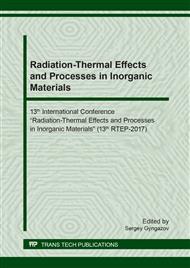p.41
p.47
p.53
p.58
p.64
p.70
p.76
p.82
p.88
High Chromium Steel Modification by the Intense Discrete Electron Beam: Structure and Properties
Abstract:
The Fe-Cr-C system thermodynamic analysis has been made. It has been demonstrated that the Fe-Cr alloys carbon alloy addition results in the significant structural-phase state change in them and exerts determinant influence on the M23С6, M7С3, M3С2 and M3С carbides existence domain by the α-and γ-phases. The temperature field numerical calculations, forming in the steel superficial layer in the case of the electron beam irradiation, have been carried out. It has been demonstrated that the peak temperature, being achieved on the sample surface towards the end of the impulse effect, is below steel melting temperature at electrons beam energy density 10 J/cm2 regardless of the electrons beam pulse duration (50-200 ms). The peak temperature on the irradiation surface is equal to the steel boiling temperature at electrons beam energy density (20-30) J/cm2 and at pulse duration 50 μs. The peak temperature on the irradiation surface achieves and increases the steel melting temperature at pulse duration 200 μs. The AISI 321 and AISI 420 steel surface irradiation has been carried out by the intense pulse electron beam. The studies have been made and the nanostructured polyphaser superficial layers formation laws analysis have been done. It has been established that the steel electronic-beam treatment is accompanied by the М23С6 ((Cr, Fe,)23C6) composition initial carbide phase particles solution, by the carbon and chromium atoms superficial layer crystal lattice saturation, by the submicron sizes and dendritic crystallization cells formation, by the titanium carbide and chromium carbide nanosized particles abstraction. The mechanical and tribological tests of the AISI 321 and AISI 420 steel samples, irradiated by the intense pulse electron beam, have been done. It has been detected that the superficial layer hardness increases in 1.5 times and the superficial layer wear resistance increases in 1.5 times. The friction coefficient decreases in 1.6 times. The microhardness increases in 1.5 times. The wear resistance increases in 3.2 times. The friction coefficient reduces in 2.3 times
Info:
Periodical:
Pages:
64-69
Citation:
Online since:
September 2018
Price:
Сopyright:
© 2018 Trans Tech Publications Ltd. All Rights Reserved
Share:
Citation:


